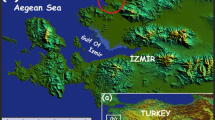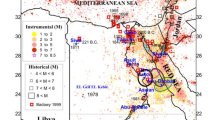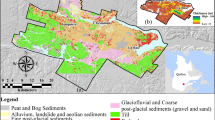Abstract
Shear wave velocity (V s) and the fundamental site period of the subsurface condition are the primary parameters that affect seismic soil amplification in particular sites. Within the topmost layer of the soil, which measures 30 m, the average shear wave velocity V s30 is commonly used to build codes for site classification for the design of earthquake-resistant structures and to conduct microzonation studies. In this study, the development of a microzonation map for V s30 distribution, National Earthquake Hazard Reduction Program V s30 site classification, and a fundamental site period for Penang are presented. The multichannel analysis of surface wave (MASW) test was conducted for more than 50 sites with available borehole data to develop the microzonation maps. The ten selected V s profiles measured by MASW show a good correlation with the data obtained using empirical correlations in a previous study. The highest V s values were identified at the northeastern and southeastern parts of Penang Island, corresponding to the shallow bedrock and the outcrop zone. Conversely, the lowest V s values were found in the northwestern and southwestern parts of the Penang mainland owing to the thick layer of soft clay and silt deposits. The site period map shows the variation in site periods, with the highest value of 1.03 s at the western part of the Penang mainland and the lowest value of 0.02 s at the eastern part of the Penang Island. The microzonation maps developed in this study are vital to studies on seismic hazard and earthquake mitigation programs in Malaysia.











Similar content being viewed by others
References
Adnan A, Hendriyawan, Marto A, Irsyam M (2005) Seismic hazard assessment for Peninsular Malaysia using Gumbel Distribution Method. Jurnal Teknologi 42 (B):57–73
Ahmad F, Yahaya AS, Farooqi MA (2006) Characterization and geotechnical properties of Penang residual soils with emphasis on landslides. Am J Environ Sci 2(4):121–128
Alexander YSW (2010) Earthquake-generating faults in Malaysia. In: National Technical Seminar on Earthquake and Tsunami, Petaling Jaya, Malaysia
Anbazhagan P, Kumar A, Sitharam TG (2013) Seismic site classification and correlation between standard penetration test N value and shear wave velocity for Lucknow City in Indo-Gangetic Basin. Pure appl Geophys 170:299–318
Antoniou AA, Papadimitriou AG, Tsiambaos G (2008) A geographical information system managing geotechnical data for Athens (Greece) and its use for automated seismic microzonation. Nat Hazards 47(3):369–395. doi:10.1007/s11069-008-9226-6
Balendra T, Li Z (2008) Seismic hazard of Singapore and Malaysia. EJSE special issue: earthquake engineering in the low and moderate seismic regions of Southeast Asia and Australia
Balendra T, Tan TS, Lee SL (1990) An analytical model for far-field response spectra with soil amplification effects. Eng Struct 12(4):263–268
Building Seismic Safety Council (2003) NEHRP recommended provisions for seismic regulations for new buildings and other structures (FEMA 450), part 1: provisions. Washington DC
Chiang CL, Mun KP (2011) Gathering of views and opinions on seismic investigations in Peninsular Malaysia—report on the IEM workshop on earthquake (part 1). In: JURUTERA, UniMap, Perlis pp 44–48
Colbourne FW (2005) Tsunami impact on the west coast of Penang Island. Emporia State University, Malaysia
Husen H, Majid TA, Nazri FM, Arshad MR, Faisal A (2008) Development of design response spectra based on various attenuation relationships at specific location. Paper presented at the International Conference on Construction and Building Technology, Kuala Lumpur, Malaysia, 16–20 June
Kramer SL (1996) Geotechnical earthquake engineering. Prentice Hall, upper Saddle River
Lermo J, Rodriguez M, Singh SK (1988) The Mexico earthquake of September 19, 1985—natural period of sites in the valley of Mexico from microtremor measurements and strong motion data. Earthq Spectra 4:805–813
Lin CP, Chang CC, Chang TS (2004) The use of MASW method in the assessment of soil liquefaction potential. Soil Dyn Earthq Eng 24(9–10):689–698. doi:10.1016/j.soildyn.2004.06.012
Luna R, Jadi H (2000) Determination of dynamic soil properties using geophysical methods. In: first international conference on the application of GEOPHYSICAL and NDT methodologies to transportation facilities and infrastructure, St. Louis, MO
Mahajan AK (2009) NEHRP soil classification and estimation of 1-D site effect of Dehradun fan deposits using shear wave velocity. Eng Geol 104:232–240
Maheswari RU, Boominathan A, Dodagoudar GR (2010a) Seismic site classification and site period mapping of Chennai City using geophysical and geotechnical data. J Appl Geophys 72(3):152–168. doi:10.1016/j.jappgeo.2010.08.002
Maheswari RU, Boominathan A, Dodagoudar GR (2010b) Use of surface waves in statistical correlations of shear wave velocity and penetration resistance of Chennai soils. Geotech Geol Eng 28(2):119–137. doi:10.1007/s10706-009-9285-9
Malaysian Mineral and Geoscience Department (2007) Geological map of Peninsular Malaysia [map], 1:1250000, JMGKEL(IT) 22/2007
Mhaske SY, Choudhury D (2011) Geospatial contour mapping of shear wave velocity for Mumbai city. Nat Hazards 59(1):317–327. doi:10.1007/s11069-011-9758-z
Nazarian S, Stokoe KH-I, Hudson WR (1983) Use of spectral analysis of surface waves method for determination of moduli and thickness of pavement systems. Transp Res Rec 930:38–45
Park CB, Miller RD, Xia JH (1999) Multichannel analysis of surface waves. Geophysics 64(3):800–808
Seed HB, Romo MP, Sun JI, Jaime A, Lysmer J (1988) The Mexico earthquake of September 19, 1985—relationships between soil conditions and earthquake ground motions. Earthq Spectra 4:805–813
Surve G, Mohan G (2010) Site response studies in Mumbai using (H/V) Nakamura technique. Nat Hazards 54:783–795
Tan CG, Majid TA, Ariffin KS, Bunnori NM (2013) Effects of site classification on empirical correlation between shear wave velocity and standard penetration resistance for soils. Appl Mech Mater 284–287:1305–1310
Tuladhar R, Yamazaki F, Warnitchai P, Saita J (2004) Seismic microzonation of the greater Bangkok area using microtremor observations. Earthq Engng Struct Dyn 33:211–225. doi:10.1002/eqe.345
Xu Y, Xia J, Miller RD (2006) Quantitative estimation of minimum offset for multichannel surface-wave survey with actively exciting source. J Appl Geophys 59(2):117–125. doi:10.1016/j.jappgeo.2005.08.002
Acknowledgments
This study was sponsored by the Postgraduate Research Grant Scheme provided by Universiti Sains Malaysia. The authors would like to extend their gratitude to the Ministry of Education of Malaysia for the permission to collect data from primary and secondary schools in the study area.
Author information
Authors and Affiliations
Corresponding author
Rights and permissions
About this article
Cite this article
Tan, C.G., Majid, T.A., Ariffin, K.S. et al. Seismic microzonation for Penang using geospatial contour mapping. Nat Hazards 73, 657–670 (2014). https://doi.org/10.1007/s11069-014-1093-8
Received:
Accepted:
Published:
Issue Date:
DOI: https://doi.org/10.1007/s11069-014-1093-8




